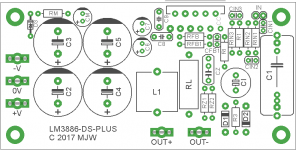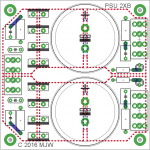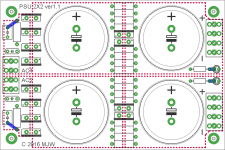Hi,
I am starting to think about my next project. I have greatly enjoyed working on my dual mono Q-Watt amp (2x 140W) from Elektor, but I didn't really plan for how cost, size, weight would scale up. It's become a monster.
For my next project, I want a much smaller mono amp of 20-30 Watts and I'll use four mono channels to power a pair of stereo speakers with electronic crossover upstream.
Can anybody suggest a device or design that would meet this requirement? Ideally would have >70% efficiency and awesome THD <0.01%.
I'm a noob so I want to build something common not exotic, where there is a good body of knowledge and support.
Thanks in advance! ! Popchops.
I am starting to think about my next project. I have greatly enjoyed working on my dual mono Q-Watt amp (2x 140W) from Elektor, but I didn't really plan for how cost, size, weight would scale up. It's become a monster.
For my next project, I want a much smaller mono amp of 20-30 Watts and I'll use four mono channels to power a pair of stereo speakers with electronic crossover upstream.
Can anybody suggest a device or design that would meet this requirement? Ideally would have >70% efficiency and awesome THD <0.01%.
I'm a noob so I want to build something common not exotic, where there is a good body of knowledge and support.
Thanks in advance! ! Popchops.
you can't get >70% efficiency unless the amps are switching types and even they will be operating down at or below for some of their operation.
Just settle for a ClassAB single pair output stage from two amplifiers driven from a common PSU.
Just settle for a ClassAB single pair output stage from two amplifiers driven from a common PSU.
Thanks Andrew.
What about LM3886 (Class D)? What's the tradeoff?
How would you choose a class AB pair? Are there any well-proven circuits/designs that would make sense for 20-30 Watts?
Also - is it practical to implement a DC regulator for an amp of this size? To allow smaller filter caps and to reduce DC ripple, mains variation etc....
Pops.
What about LM3886 (Class D)? What's the tradeoff?
How would you choose a class AB pair? Are there any well-proven circuits/designs that would make sense for 20-30 Watts?
Also - is it practical to implement a DC regulator for an amp of this size? To allow smaller filter caps and to reduce DC ripple, mains variation etc....
Pops.
TI have categorised it as "Analog Input Class D" on Analog, Embedded Processing, Semiconductor Company, Texas Instruments - TI.com. But then the PDF says "Quasi AB".
Your link doesn't show me that, but I recall seeing similar elsewhere. I have no explanation for that.
Rest assured it is not digital
Rest assured it is not digital
Also - is it practical to implement a DC regulator for an amp of this size? To allow smaller filter caps and to reduce DC ripple, mains variation etc....
Pops.
I say no for your application. Regulator for power amps would have to be high current, use high power devices, and would waste a lot of power. Plus you're not going to save any space, effort, or cost.
Why the aversion to big caps? Size? Price? You can use an array of smaller caps instead - say 8 x 2000uF/50V instead of 7800uF/50V. You get a discount usually for buying 10 and an even bigger discount for buying 25.
Look at these bad boys. https://www.digikey.com/product-detail/en/nichicon/UHE1H222MHD6/493-1629-ND/589370 10000 Hrs @ 105°, 2.944A @ 120Hz ripple current, about 3/4" diameter by 1.5" tall. That's 12 amps ripple current from 4 in parallel- is that sufficient for your scheme? 4.25 mOhm ESR with 4 in parallel - will that work? You get 10 for $22.31. That's 2 left over - or just use 5 in parallel.
LM3886 is a bit of overkill for 30 W/ch. At $7.80 each they are not cheap either.
I'm building a 25 W/ch stereo LM1875 amp. About $2.80 each. I'm using a 3 amp 24-27-30-33-36 volt EI transformer, into a bridge and then a 3300 uf filter cap. My 60 W/ch ST120 stereo amp uses 3300 uf and doesn't seem to run out of power. Runs out of heat sink first. I'm using the 24 VAC output since the datasheet shows highest soa at the lower voltages. A 3300 uf 63 v filter cap is about $3 and a 4700 about $3.50.
Per the datasheet example, there are 470 uf filter caps on the board <2" from the IC, also 0.1 uf ceramic parallel. When the power wire ran direct out to the edge where the 24v came from, about 3.25 inch, the unit oscillated. Power & ground now run direct to the 470 cap.
If you want a little more watts the next step up is a LM3875.
I'm building a 25 W/ch stereo LM1875 amp. About $2.80 each. I'm using a 3 amp 24-27-30-33-36 volt EI transformer, into a bridge and then a 3300 uf filter cap. My 60 W/ch ST120 stereo amp uses 3300 uf and doesn't seem to run out of power. Runs out of heat sink first. I'm using the 24 VAC output since the datasheet shows highest soa at the lower voltages. A 3300 uf 63 v filter cap is about $3 and a 4700 about $3.50.
Per the datasheet example, there are 470 uf filter caps on the board <2" from the IC, also 0.1 uf ceramic parallel. When the power wire ran direct out to the edge where the 24v came from, about 3.25 inch, the unit oscillated. Power & ground now run direct to the 470 cap.
If you want a little more watts the next step up is a LM3875.
Last edited:
Hello!
Maybe it's not practical, but i have build such supply for a power amp back in 1979. Have a look:... is it practical to implement a DC regulator for an amp of this size? ....
Thanks indianajo. Sounds like a great project. I also saw the LM1875... but for the same +/-25V power supply it looks like the LM3886 has almost 10x lower noise at 20W (?)... and of course higher price.
I love the great app guidance and pcb layout in the TI pdf for the LM1875. Thanks again.
I love the great app guidance and pcb layout in the TI pdf for the LM1875. Thanks again.
Popchops, in case this interests you
AUDIO CLASS-D POWER AMPLIFIER
https://www.elektormagazine.com/labs/audio-class-d-power-amplifier.
It's says "the amplifier sports a -3 dB bandwidth of 7 Hz to 70 kHz and can deliver up to 30 watts into an 8 ohms loudspeaker"
AUDIO CLASS-D POWER AMPLIFIER
https://www.elektormagazine.com/labs/audio-class-d-power-amplifier.
It's says "the amplifier sports a -3 dB bandwidth of 7 Hz to 70 kHz and can deliver up to 30 watts into an 8 ohms loudspeaker"
Last edited:
Thanks Calpe. I don't fancy SMD though - prefer through-hole assembly.
I really like the look of the LM3886 with +/-24V supply.
I saw this: A Complete Guide to Design and Build a Hi-Fi LM3886 Amplifier - Circuit Basics
and this: Single Chip 50W Stereo Amplifier
Not sure I'm up for creating my own amp PCB; I'm more than happy to buy the PCB (from ESP). I might do my own power supply PCB.
Any other suggestions for ~25W into 8 Ohms?
Cheers - Pops.
I really like the look of the LM3886 with +/-24V supply.
I saw this: A Complete Guide to Design and Build a Hi-Fi LM3886 Amplifier - Circuit Basics
and this: Single Chip 50W Stereo Amplifier
Not sure I'm up for creating my own amp PCB; I'm more than happy to buy the PCB (from ESP). I might do my own power supply PCB.
Any other suggestions for ~25W into 8 Ohms?
Cheers - Pops.
https://www.sparkfun.com/datasheets/Components/General/STA540.pdf
generally a chip i far too often recommend as a pretty versatile workhorse for... just about any home audio application.
generally a chip i far too often recommend as a pretty versatile workhorse for... just about any home audio application.
Popchops, I am working on something similar to what you want to build.
The LM3886 PCB design is ready and pretty much follows the datasheet recommended parts and layout. I added additional parts so they can work in a multi-channel amp.
Still deciding on the configuration of the active filter. Several designs almost ready.
Are you planning to build four channels in one chassis? If so, it's a challenge in preventing hum caused by ground loops.
Let me know if you're interested and up for a challenge.
I can supply boards, schematics and parts.
The LM3886 PCB design is ready and pretty much follows the datasheet recommended parts and layout. I added additional parts so they can work in a multi-channel amp.
Still deciding on the configuration of the active filter. Several designs almost ready.
Are you planning to build four channels in one chassis? If so, it's a challenge in preventing hum caused by ground loops.
Let me know if you're interested and up for a challenge.
I can supply boards, schematics and parts.
Last edited:
TDA 7293 is often cited as an alternative to LM3886. ESP PCB available for it too
Interesting Scott... thanks. TDA 7293 seems to have higher THD above 5kHz? Pretty impressive at the bass end.
Is there a popular discrete 'kit' alternative to these chips? Only want 25W but with low distortion, class A/B.
It will have to drive 8 Ohm woofers and 4 Ohm tweeters.
Are you planning to build four channels in one chassis? If so, it's a challenge in preventing hum caused by ground loops.
Let me know if you're interested and up for a challenge.
I can supply boards, schematics and parts.
Hi Mark.
I was planning separate stereo amps each say 2x30W into 6R for the following reasons:
1) A stereo power amp is generically more useful. My parents need one for their TV....
2) Can be positioned closer to each speaker... shorter cables.
3) Would require separate power supplies, but I would expect to use one 200VA toroid in each stereo unit. No soft start...
4) A bit easier to engineer in terms of ground loops... maybe.
How does your board compare to the two I linked above? What are you planning for decoupling? 22uF + 100 nF? Or three caps?
I would like to know you power supply scheme...
Cheers - Pops.
Is there a popular discrete 'kit' alternative to these chips? Only want 25W but with low distortion, class A/B.
Hi. I'm not sure what you mean, a kit of discrete components for an amplifier with a similar spec.?
Hi Scott - yes, a mature design and ideally a PCB for a low distortion class AB amp 25-30 Watts. My gut feeling is that a discrete design would have lower distortion than the chip amps? I'm not really up for laying out a PCB though.
The power requirements for the transformers are less. The tweeter will use less power than the mid/low driver. 30+10 watts per speaker should be enough. Double that, and you get an 80 to 100VA transformer per speaker.
A 200VA transformer does give you the option to use them as 2x50W amps.
The amp board (100x50) uses HF, MF and LF capacitors. Full options as described in the datasheet, plus a few extra's so that they can work in a multi-channel amp.
PSU board options (75X75) or (80x120).
A 200VA transformer does give you the option to use them as 2x50W amps.
The amp board (100x50) uses HF, MF and LF capacitors. Full options as described in the datasheet, plus a few extra's so that they can work in a multi-channel amp.
PSU board options (75X75) or (80x120).
Attachments
- Status
- Not open for further replies.
- Home
- Amplifiers
- Chip Amps
- Small (30W) amplifier for biamplification


